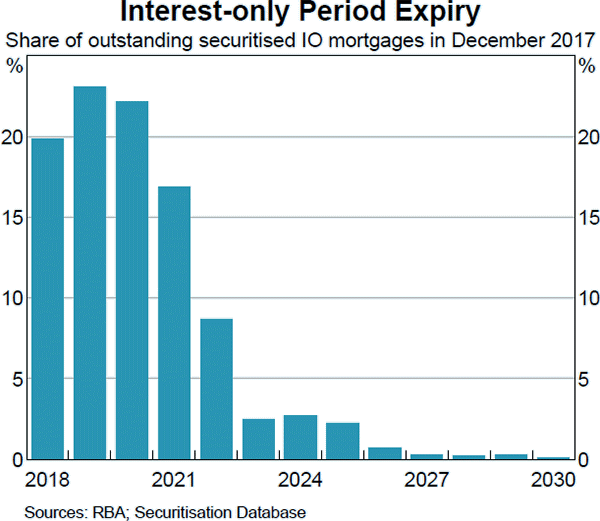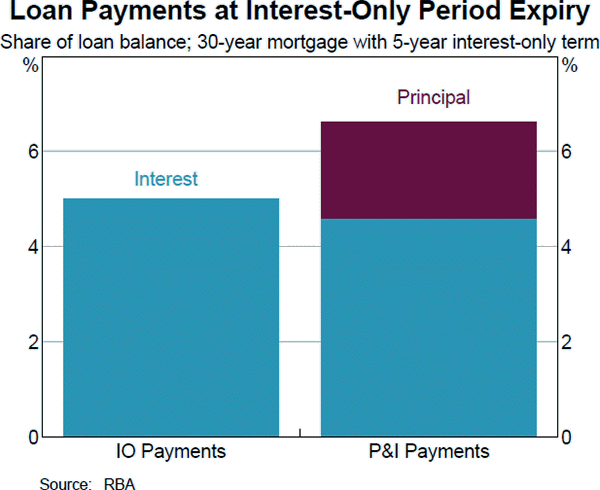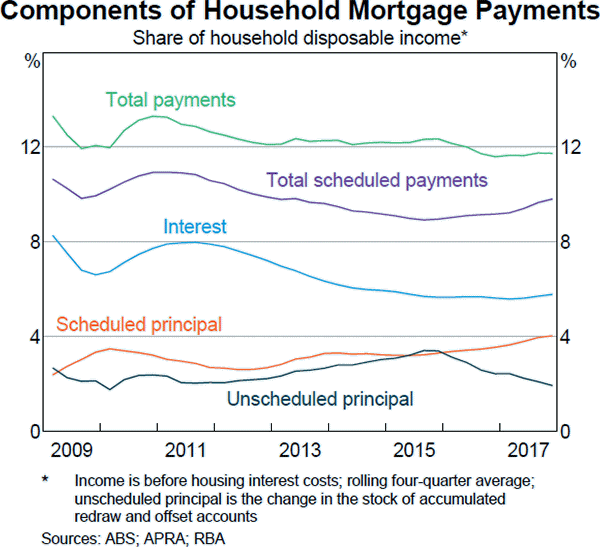Statement on Monetary Policy – May 2018 Box C: The Expiry of Interest-only Loan Terms
Many mortgages in Australia are on interest-only (IO) terms. Households take out IO loans for a number of reasons, such as tax incentives and payment flexibility.[1] However, other things equal, IO loans can carry greater risks compared with principal-and-interest (P&I) loans. They allow borrowers to remain more indebted for longer and entail a sizeable step-up in required payments (to include principal) when the loan converts to being a P&I loan.
IO loans had grown rapidly for a number of years in an environment of low mortgage rates and heightened competitive pressures for new loans among lenders (Graph C1). The share of outstanding housing credit on IO terms increased to almost 40 per cent by 2015. The share on IO terms has always been much higher for investors than owner-occupiers (consistent with the associated tax benefits for investors). But IO loans for owner-occupiers had also grown strongly.
In 2014 and 2015, the Australian Prudential Regulation Authority (APRA) and the Australian Securities and Investments Commission (ASIC) took some measures to reinforce sound housing lending practices, including some that affected IO loans.[2] ASIC also reinforced its position that owner-occupier loans should not have their IO periods extended beyond five years. Then, in March 2017, APRA announced a benchmark that authorised deposit-taking institutions (ADIs) should limit their new IO lending to 30 per cent of total new residential mortgage lending and, within that, they should tightly manage new IO loans extended at high loan-to-valuation ratios (LVRs).[3] Following the introduction of these measures, most banks decided to raise interest rates on IO loans to be about 40 basis points above interest rates on equivalent P&I loans. This has contributed to a reduction in the demand for new IO loans and provided existing borrowers with an incentive to switch to P&I loans. Many households switched willingly in 2017 in response to pricing differentials. As a result, the stock of IO loans in total housing credit has declined from close to 40 per cent to almost 30 per cent and the share of new IO loans in total approvals has fallen well below the 30 per cent limit.

The Reserve Bank's Securitisation Database suggests that the IO period is due to expire by 2020 for around two-thirds of the outstanding stock of securitised IO loans (as at end December) (Graph C2).[4] This is consistent with IO periods typically being around five years. The profile of IO period expiries implies that about $120 billion of IO loans in aggregate are scheduled to roll over to P&I loans annually over the next three years, or around 7 per cent of the stock of housing credit each year. This volume is not unprecedented. What is different now, however, is that lending standards were tightened further in recent years. This tightening in lending standards, coupled with ASIC reinforcing its position that owner-occupier loans should not have their IO periods extended beyond five years, could affect the ability of some borrowers to extend the IO period or to refinance to a P&I loan with a longer amortising period so as to reduce required payments on the loan.

The following simple scenario examines the potential effect of the upcoming IO loan expiries on households' cash flows and consumption.[5] By assuming that all of the IO loans revert to P&I as scheduled – which is unlikely – it provides an upper bound estimate of the effect of the transition ahead.
Consider a typical borrower with a 5-year IO period on a 30-year loan and an IO interest rate of 5 per cent. Such a borrower's mortgage payments would increase by around 30–40 per cent when their IO period ends and they begin making P&I payments at a lower interest rate of around 4½ per cent (Graph C3).

The rise in scheduled payments amounts to about $7,000 per year for the typical IO loan in the Securitisation Database (of around $400,000). For such households, this is a non-trivial sum. The effect on their consumption though will depend on the extent to which they have planned and provisioned for this predictable step-up in payments.
This effect on the typical borrower can be scaled up to get a sense of the size of the aggregate cash flow effect across all households. As a share of total household sector disposable income, the cash flow effect is estimated be around 0.15 to 0.2 per cent of household income on average per annum over each of the next three years. So for the household sector as a whole, this effect is relatively modest.
The actual cash flow effect is likely to be lower than this for a number of reasons and the effect on household consumption is likely to be lower still.
Firstly, many borrowers make provisions ahead of time for the rise in required repayments. It is common for borrowers to build up savings in offset accounts, redraw balances or in the form of other assets. They can draw upon these to cover the increase in scheduled payments or reduce their debt. Others may not even need to draw down on existing savings. Instead, they can simply redirect their current flow of savings to cover the additional payments. There is evidence that this has been the case for many borrowers that have already switched from IO loans to P&I loans (Graph C4). Scheduled housing loan repayments have increased over the past year as a result of the large number of borrowers switching to P&I loans. Meanwhile, unscheduled payments have declined. With total payments little changed, the rise in scheduled payments has had no obvious implications for household consumption.
Other borrowers could draw upon existing savings to cover the increase in scheduled payments or reduce their debt. About half of owner-occupier loans have prepayment balances of more than 6 months of scheduled payments. Some of the borrowers with more modest balances have relatively new loans; they have not had time to accumulate large prepayment balances nor are they likely to be close to the scheduled end of their IO period. Investor loans typically have smaller prepayment balances – offset or redraw – compared with owner-occupier loans, consistent with the associated tax incentives. However, in comparison to households that only hold owner-occupier debt, there is evidence that investors tend to accumulate higher savings in the form of other financial assets (such as prepayment balances on their owner-occupier home loan, equities, bank accounts and other financial instruments).

Secondly, some borrowers will be able to negotiate an extension to their IO period with their current lender or refinance their IO loan with a different lender. Other borrowers may be able to refinance their loan into a new P&I loan, thereby reducing required payments by repaying the principal over a longer term. Based on loans in the Securitisation Database, a large majority of borrowers would be eligible to alter their loans in at least one of these ways. Even for those borrowers unable to roll over to another IO period, most appear to be in a position to service the required P&I repayments.
Thirdly, some borrowers may decide to sell their property to repay their loans, even if this is not their preferred outcome. With significant price appreciation in the housing market in recent years, estimates from the Securitisation Datasbase suggest that many of the households currently facing an IO period expiry will have experienced significant growth in their equity in the property (which may also help them to refinance into a longer P&I term if they desired it). The most vulnerable borrowers would likely be owner-occupiers that still have a high LVR and who might find it more difficult to refinance or resolve their situation by selling the property.
Currently it appears that the share of borrowers who will not be able to afford higher P&I repayments and are not eligible to alleviate their situation by refinancing is small. Liaison with the banks suggests that there are a few borrowers needing assistance to manage the transition. Over the past year, some banks have reported in liaison that there has been a small deterioration in asset quality. For some borrowers this has tended to be only temporary as they take some time to adjust their financial affairs to cope with the rise in scheduled payments. For a small share of borrowers though, it reflects difficulty making these higher repayments. That share could increase in the event that an adverse shock led to a deterioration in overall economic conditions.
The transition to more limited use of IO loans over the past year has been relatively smooth overall. While that is likely to continue to be the case, this is an area the Bank will continue to monitor closely.
Footnotes
For more information see RBA (2017) ‘Box B: Interest-only mortgage lending’, Financial Stability Review, April, pp 26–28. [1]
For further details, see RBA (2015) ‘Box B: Responses to Risks in the Housing and Mortgage Markets’, Financial Stability Review, March, pp 45–47. [2]
APRA (2017), ‘APRA announces further measures to reinforce sound residential mortgage lending practices’, Media Release No 17.11, 31 March. [3]
Although the Securitisation Database is not necessarily representative of the entire mortgage market across all its dimensions, the aggregate share of IO loans in the Securitisation Database is similar to other measures that cover the broader housing market. For further detail on the Securitisation Database see footnote 1 in the ‘Domestic Financial Conditions’ chapter. [4]
For more detail see Kent C (2018) ‘The Limits of Interest-only Lending’, Address to the Housing Industry Association Breakfast, Sydney, 24 April. [5]